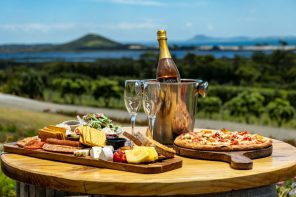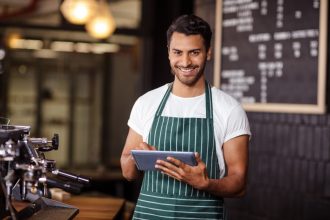New Zealand has a reputation as a young and vibrant nation, willing to try new things and constantly innovating. This is evident in the foodservice sector, where back-of-house technology has been embraced by chefs and owners alike. The success of homegrown food safety apps like Chomp and iMonitor also speak to the willingness of restaurateurs to use technology to boost business behind the scenes.
However, when it comes to customer-facing technology, New Zealand lags behind. Voice-ordering, interactive tablets and kiosks are becoming increasingly commonplace in markets such as the USA and UK, but have generally failed to take off here. Tablets are common in cafés to communicate between wait staff and the kitchen, but not between the customer and the wait staff. Searchfield Electrical has attempted to bridge that gap with the Noodoe system, which opens up communication between wait staff and the customer by way of a small tabletop block, which can be used to request water, the bill or service, among other things.
“When we were demonstrating the system, people saw the need for this technology. Everyone knows there’s a problem,” said Alan Swafford, director of Searchfield Electrical. “New Zealand has a reputation for creating and embracing clever technology, but restaurants seem reluctant to take it on board.”
He believes that restaurant owners need to start looking at technology from a purely financial standpoint and that a lot of restaurant owners haven’t looked deep enough into the benefits.
“I don’t think restaurants are aware of just how much money technology can save them,” he said. “Good staff are hard enough to find, and these systems can actually train staff as they go. Restaurant owners just need to sit down and do the numbers.”
That’s not to say that no technology has been adopted. One Tree Grill in Auckland gives guests an iPad, which shows pictures of menu items as well as wine pairings. The idea, which had been discussed as early as 2012, was described by One Tree Grill owner Guy Malyon as “exciting but equally terrifying” and was launched in 2015.
“We wanted to embrace the new technologies available and explore the idea of iPad menus but couldn’t find anything on the market, so we decided to enlist the help of developers to build one for ourselves,” he said.
However, customers cannot order food through the app and must still interact with a waiter to place their order.
“Our wait staff remain an important part of our business and are still on hand for any questions customers have about menu options,” Malyon said. “We made it very clear from the beginning that we didn’t want the new iPad menus to diminish the part of our wait staff, but rather add to the customer experience.”
For smaller restaurants, price is a major factor when making the decision to take on technology. A diner such as iHop in the USA can trial technology in any number of stores across a wide geographical area and make a well-informed decision before investing in expensive technology – a luxury afforded to few in the New Zealand restaurant market, which is dominated by independent owner-operators. What is well-received in Christchurch may be ignored in Wellington, and technology embraced by customers on Auckland’s North Shore may be rejected in the CBD. There are very few restaurant groups which span the length of the country, and have enough outlets of the same brand in which to trial technology.
New Zealand lacks a large fast-casual sector, which often the hub of innovation in overseas markets. This is where QSR chains have the advantage, and as such are leading the technological charge. McDonald’s introduced their self-order kiosks as part of the introduction of the gourmet burger range in 2015 and 2016, as well as adding digital menu boards and table service. McDonald’s has a number of technology projects rolling out and planned for the future. The company recently updated the operating system and user interface for the kiosks, taking on board customer feedback, and new functionality is set to be added.
“The kiosks quickly proved popular with customers, providing them with the ability order in their own time,” said McDonald’s spokesperson Simon Kenny. The use of kiosks continues to grow, but it has not come at the expense of any staff members.
“Customers are increasingly using kiosks to place orders, but this has not reduced the number of staff required at any given time,” he explained. “We now have staff in the lobby assisting customers using the kiosks, and also doing table delivery.”
However, despite the claims of success, no other QSR chain in New Zealand has implemented self-order kiosks. Wendy's, Burger King and Restaurant Brands were unavailable for comment.
New Zealand’s isolated dining culture may also play a part, as Australia has also been slow on the uptake of customer-facing restaurant technology. Justin Hemmes, CEO of the Merival Group which owns more than 65 hospitality venues, recently addressed the issue at Australia's Top Restaurants Business of Food Forum.
“I feel that we're one of the few industries that will be less disrupted by technology than most," he said. "It drives people to embrace the social element of dining and drinking. I feel that thankfully, it's not going to disrupt our industry, it will probably enhance it."






